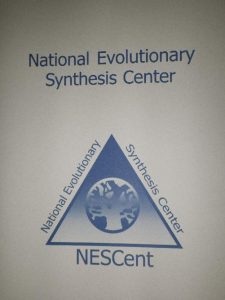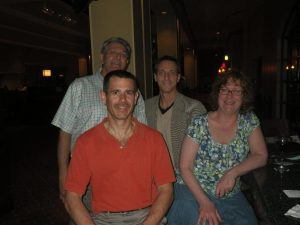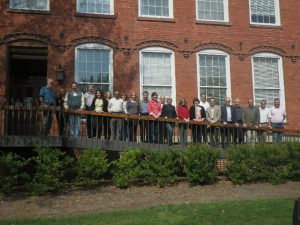I wrote this article and had it recently published in my dental society's journal. Read it to the end and you will see that I am trying to reacquaint the dental community with the works of Dr. Weston Price. This is how I am getting the message out within the dental community:
The very first meeting held March 27-29, 2012 tying dentistry to evolution just wrapped up at the National Evolutionary Synthesis Center (NESCent) at Duke University in North Carolina. About twenty attendees including myself and other clinical dentists met with some of the top researchers today in the fields of Anthropology, primate growth, and biomechanics to ascertain how it is that Paleolithic humans seems to have better dental health than we currently see today.
NESCent is a nonprofit science center dedicated to cross-disciplinary research in evolution. NESCent is jointly operated by Duke University, The University of North Carolina at Chapel Hill, and North Carolina State University, and is sponsored by the National Science Foundation. Their mission is “promotes the synthesis of information, concepts and knowledge to address significant, emerging, or novel questions in evolutionary science and its applications. NESCent achieves this by supporting research and education across disciplinary, institutional, geographic, and demographic boundaries.” While many branches of medicine have used this approach, this was a first for dentistry.
The director of the meeting was Dr. Peter Ungar, Distinguished Professor and Chairman of Anthropology, University of Arkansas and co-chaired by Jerome Rose, also of the University of Arkansas and myself. In summary, we were seeking to explore and answer such things as: Cavities, gum disease, dental defects, crooked and crowded teeth, tooth loss – these problems are a scourge on our society. But they are rare in traditional foraging peoples, and almost unknown in our distant ancestors. This NESCent Catalysis meeting explored the idea that many of our dental and orthodontic problems relate to a mismatch between the chemical and physical properties of the foods we eat today, and those to which our jaws and teeth evolved. It brought together researchers in the fields of evolutionary biology, paleopathology, biomechanics, and food science, both with one another and with clinicians, to explore the implications of the evolution of human teeth and jaws for dentistry and orthodontics. The goals of this meeting were to 1) summarize the current state of the science, 2) identify areas for future research, 3) foster new collaborations, and 4) begin a dialog that will ultimately chart a way forward for further applications of evolutionary theory to clinical practice, and development of Evolutionary Dentistry as a discipline.
As a clinician, one of my charges was to look for ways that we could apply the principles of early humans to today’s population and I have several interesting things to report. Paleolithic humans stretched over a very long period of time. From about 2.5 million years ago until about 10,000 years ago. We are defined as “human” by out genus, Homo, not our species. Homo sapiens did not appear until about 250,000 years ago. Malocclusions from this vast time period are present in LESS than 5% of remains. Nor are they prevalent in current cultures eating a traditional diet. Impactions are just as rare. They wore thru their enamel by the time they were middle aged yet caries was almot non-existent. In addition caries rarely, but does occur in our closest ape relatives such as chimpanzees and lowland gorillas but is rare in mountain gorillas.
In terms of developing modalities to lower the rates of occurrence of malocclusions in modern Americans it was noted that Paleolithic populations breastfed for longer periods of time and that the motion of the tongue helps to stimulate the growth and elongation of the pre-maxillae. It was also shown that bottle-feeding does not allow for this motion. Long-term breastfeeding leads to a more prognathic lower facial profile, wider palate and larger airway. It was speculated that such a facial profile would lower the incidence of seasonal allergies, sleep apnea, and tonsilar enlargement. A wider nasal passage and airway will allow greater airflow so that there would be less mouth breathing. It was further speculated that this might reduce non-apnetic snoring. Nasal breathing allows for greater humidification of the air that stimulates various pathways that allow this to happen. The benefits here go far beyond just dentistry.
Caries was just about non-existent because simple sugars and the refined carbohydrates that cause them were just not present in any Paleolithic diet. Since the Paleolithic covered such a vast period of time and many, many different populations it is important to remember that there is no one “Paleolithic Diet,” but rather a continuum or “envelope” of certain related types of foodstuffs that were consumed. These included but were not limited to fish, shellfish, leafy green plants, root vegetables, and fruit in season. It was interesting to note that there is decay in some lowland gorillas. It is present mostly as interproximal decay on the upper anterior teeth. It was speculated that sucking on fruit or raiding human garbage dumps, common in the area, caused this. In either case it shows that our closest living relatives are not very well adapted to eat sugar either.
In pre-Columbian American cultures caries and orthognathic problems are confined to the agriculturalists and their maze eating civilizations. The hunter-gatherer cultures had little or none of these problems. Imagine the implications of applying this principle to modern Americans. With proper education we can reduce if not eliminate these diseases in a generation.
As for modalities to prevent decay, returning to this envelope would be ideal and is certainly doable. Dental maladies should be counted among those diseases that are considered “diseases of civilization, “ or “diseases of affluence.” Sugar is not a required nutrient. Starchy foods that break down rapidly into simple sugars including whole and refined grains should not be staples of the American diet anymore. Foodstuffs, such as protein and healthy fats that were common in the Paleolithic time should become common again. Some examples of healthy fat include nuts, avocados, grass fed meat, and whole coconuts.
In the first half of the twentieth century noted dentist Dr. Weston Price traveled the world and noted both the healthy teeth of peoples consuming their traditional diet as well as the devastation wrought by consuming modern foods by these same populations. He referred to sugar, flour, and cereal grains as “The displacing foods of modern commerce.” It seems that what was old is new again. It appears that with education and some reorientation of thought that we have the ability to eliminate these diseases within one generation. As dentists it is our duty and obligation to do so.




Excellent article Dr Sorrentino! What work you are doing as a practicing dentist to be helping those within the dental field (and the vast majority of the public) become aware of this truth. Thank you for your work and contribution to society in this crucial way! To your health! Will and Susan of OraWellness
Hey this is my first visit to your blog... really nice... and your article is very good... and keep the service going on Dr. Sorrentino.. Greetings!!